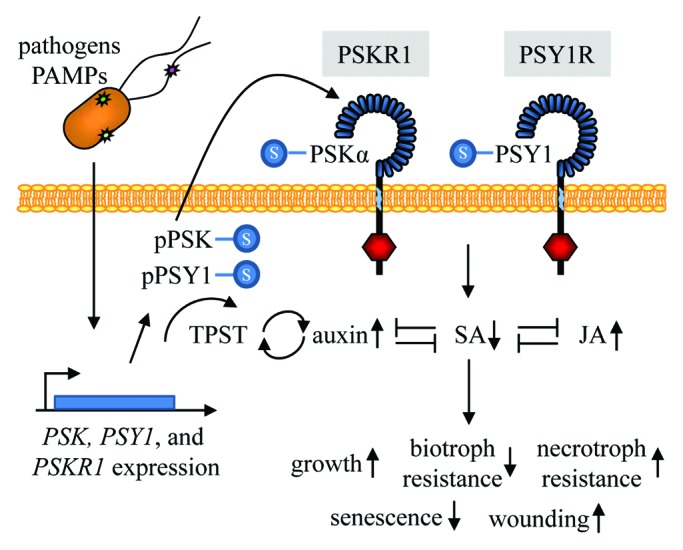Figure 3.

Tyrosine-sulfated peptide signaling in plant defense. PSKR1,PSK1,2 and 4, and PSY1 are induced by Pseudomonas syringae pv tomato DC3000 infection and by PAMPs (depicted as stars in a bacterial cell).17 The preproproteins pPSK and pPSY1, are tyrosine-sulfated (-S) by TPST which most likely takes place in the Golgi apparatus.7 The preproproteins are thought to be proteolytically processed in the apoplast at least in part by subtilisins.31 The fully processed PSKα-S and PSY1-S peptides are then able to bind to their respective receptors, PSKR1 and PSY1R.5,6 Receptors consist of an extracellular leucine rich repeat domain (blue), a single transmembrane domain (light blue) and a cytosolic kinase domain (red). Activation of these receptors leads to the suppression (↓) of SA signaling and consequently suppressed resistance to biotrophic pathogens17 and senescence3 as well as the upregulation (↑) of JA signaling and consequently increased resistance to necrotrophic pathogens17 and increased wounding responsiveness.3,5 PSKα and PSY1 signaling also promotes plant growth2,3,5 and this growth is dependent on auxin.21 TPST expression is induced by auxin signaling and TPST activity promotes the upregulation of auxin signaling,32 suggesting that auxin and TPST pathways are tightly linked. Mutually antagonistic regulation (-|) of auxin, SA and JA have been reported.33 The interplay of these three phytohormones may explain all reported PSKR1- and PSY1R-related phenotypes.
